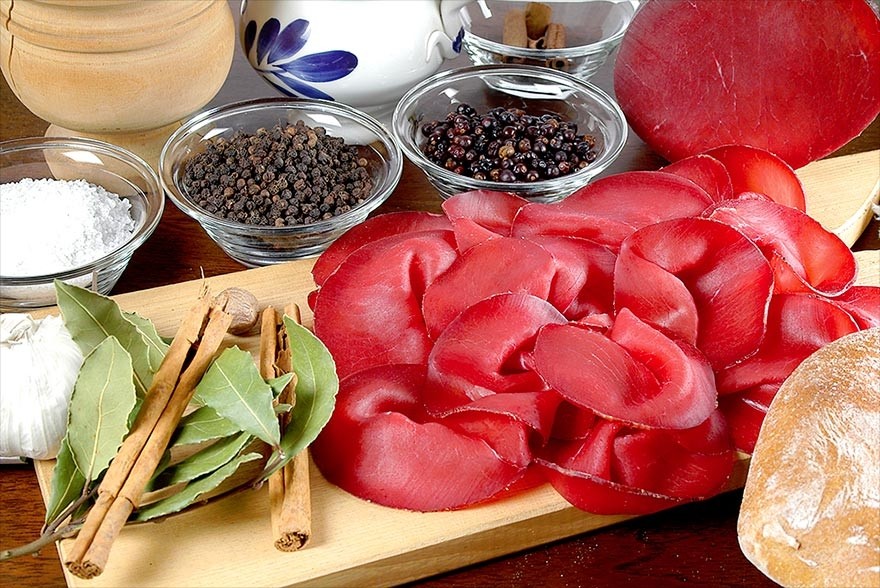Bresaola from Valtellina P.G.I.
Product description
Bresaola della Valtellina PGI is a charcuterie product obtained exclusively from the salted and cured thigh of bovine between 18 months and four years old.
It can be produced in the following varieties: Punta d’Anca (loin), Sottofesa (top beef), Magatello (round roll), Sottosso (silverside), and Fesa (rump).
Production method
The meat is carefully selected and trimmed before being dry salted with salt and natural herbs; it is then left to rest in brine for a period of at least 10 days.
During this period, the meat is massaged to induce more rapid and even salt migration within the product. It is then made into a natural or artificial gut sausage, which is left to dry and cure in special cells with a temperature of between 12 and 18°C to ensure a slow and gradual reduction of the moisture in the product; the storage areas are air conditioned, ensuring sufficient exchange of air. Both the drying and curing processes last for a period of four to eight weeks, during which time the characteristics that make the product unique and incomparable develop.
Apparence and flavour
Bresaola della Valtellina PGI is characterised by a uniform bright red colour, with a slightly darker rim in the lean part and fine white veins in the fatty part.
It has a firm and elastic consistency, a mild aromatic fragrance and a pleasant and slightly savoury flavour.
Gastronomy
Bresaola della Valtellina PGI should be kept in a cool dry place; once sliced, it should be placed in the fridge.
It is generally consumed fresh in thin slices, but it is also delicious as a basic ingredient in the preparation of starters and main courses.
A local traditional dish is Bresaola della Valtellina PGI “Santa”, in which the product is served with juniper butter curls and rye bread.
Another much appreciated dish is Carpaccio of Bresaola della Valtellina PGI dressed with extra-virgin olive oil and lemon, and served with rocket and slivers of Parmigiano Reggiano PDO.
It is also delicious in first courses such as rice with Bresaola and Bitto cheese.
Marketing
The product is marketed as Bresaola della Valtellina PGI, in the following typologies: Punta d’Anca, Sottofesa, Magatello, Fesa, Sottosso.
The first three varieties are the most common. It is sold whole, in pieces, vacuum-packed, in modified atmosphere packaging or sliced.
Distinctive features
The most indispensable elements for the production of Bresaola della Valtellina PGI are the accurate dosage of the seasoning and the massaging of the meat during the preparation stage.
History
The origins of Bresaola della Valtellina PGI date back to the late Middle Ages; in fact, in this period the technique of preserving beef, lamb and game through salting and drying was already diffused throughout the Alps.
The term Bresaola, in the past brazaola, brisaola or bresavola, has uncertain origins.
Although the suffix “saola” can be traced easily back to the use of salt in the preserving of the product, it is much more difficult to individualise a single and agreed upon interpretation of the origins of the whole term. According to a first interpretation, the etymology can be found in the German word brasa (embers), as in the past embers were used to reheat
and dehumidify the air of the curing rooms, emitting aromatic smoke that was obtained by adding juniper berries and bay leaves to the hot coals. Another interpretation indicates that the origin of the name can be found in the dialect term brisa, which indicates a heavily salted beef gland.
Production area
The production area of the Bresaola della Valtellina PGI is within the entire territory of the Sondrio district, in the Lombardy region.
Operators: 16
Production(KG): 12.371.710
Turnover(MLN€): 238,55

 IT
IT 